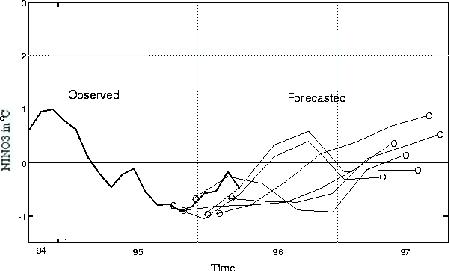
[Previous Article]
[Next Article]
Forecasts of Nino 3 SST Using a
Data Assimilating Neural Network Model
contributed by Benyang Tang, William Hsieh and Fred Tangang
Department of Earth and Ocean Sciences, University of British Columbia, Vancouver, B.C., Canada
Web site of the UBC Climate Prediction Group:
http://www.ocgy.ubc.ca
A neural network model has been developed for forecasting
the tropical Pacific SST in the Nino 3 region. Based on our earlier neural
network models (Tang et al. 1994; Tangang et al. 1996), this current model
has a number of new techniques added to better deal with noisy data, mainly
the additional continuity term and the Aclearning@ term in the cost function.
The word Aclearning@ is derived from Alearning@ and Acleaning@, meaning
that the neural network learns from the data and cleans the data at the
same time (Weigend et al. 1996). In the March 1996 issue of this Bulletin,
the detail of this model was described, and the hindcast and retrospective
forecast skills were given.
The data used for training are the NiZo 3 SST index and
the first 4 EOF coefficients of the FSU monthly wind stress data (Goldenberg
and O'Brien 1981). The seasonal cycle, calculated from the 1961-90 data,
has been removed from the NiZo 3 data. Before the EOF calculation, the
wind data were first smoothed with one pass of a 1ş2ş1 filter in zonal
and meridional directions and in time, and detrended and deşseasoned by
subtracting from a given month the average of the same calendar months
of the previous four years. This preşEOF processing is the same as that
used in Lamont's coupled model (Cane et al. 1986) and in Tang (1995).
The inputs of the neural network for a given month consist
of the NiZo 3 index and the first 4 wind EOF coefficients of the month
and the same 5 numbers for the month that is 3 months earlier, amounting
to 10 inputs to the network. These inputs feed into a hidden layer with
4 sigmoidal neurons, which in turn feed into 5 linear output neurons, giving
the NiZo 3 and the first 4 wind EOF coefficients for the month that is
3 months later. Thus, the time step of the neural network is 3 months.
By repeatedly applying the model output as input to the neural network,
we can obtain forecasts for longer lead times. There are 420 training pairs
(i.e., sets of predictors and predictands) in the 1961-95 period.
To estimate the forecast skill, retroactive real time
forecasts 1986-1995 were carried out. Figures 1 and 2 of the March 1996
issue of this Bulletin show the skill in terms of correlation and RMS error
for retroactive real time as well as hindcasts for a longer historical
period. Skills are seen to be competitive with other empirical forecast
approaches such as analogs or linear regression.
The model we use here is the same as the one we used in
the last issue of this Bulletin. However, the initial conditions have been
adjusted with the new data using the same optimization as the model training,
in a way similar to initialization of adjoint data assimilation.
Figure 1 shows the latest forecast using a neural network
trained with data up to April 1996. Six forecasts of lead times of up to
18 months were initiated from October to March 1996. Our forecast calls
for a normal, or a slightly cool tropical condition in the 1996-97 boreal
winter. We caution that our forecasts using data up to February 1996 called
for a warm 1996-97 winter; now with the March and April data added, the
forecasts became cooler.
The forecast of our neural network model is updated monthly
in our web site. In addition, our web site issues forecasts by a POP model
(Tang 1995). The POP model forecasts the continuation of the current cold
condition for the coming season, but has not called for any warm or cold
event for the 1996-97 winter so far.
References
Cane, M.A., S.E. Zebiak and S. Dolan, 1986: Experimental
forecasts of El Nino. Nature, 321, 827ş832.
Goldenberg, S.B., and J.J. O'Brien, 1981: Time and space
variability of tropical Pacific wind stress. Mon. Wea. Rev., 109,
1190ş1207.
Tang, B., 1995: Periods of linear development of the ENSO
cycle and POP forecast experiments. J. Climate, 8, 682ş691.
Tang, B.,G. Flato and G. Holloway, 1994: A study of Arctic
sea ice and sea level pressure using POP and neural network methods. Atmos.şOcean,
32, 507ş529.
Tangang, F.T., W.W. Hsieh and B. Tang, 1996: Forecasting
the equatorial Pacific see surface temperatures by neural network models.
Climate Dynamics, accepted.
Weigend, A.S, H.G. Zimmermann, and R. Neuneier, 1996:
Clearning. In Neural Networks in Financial Engineering. Refenes,
P., Y. Abu-Mostafa, J.E. Moody and A.S. Weigend, Eds. Proceedings, Neural
Networks in the Capital Markets, October 1995, London, UK. In press.

Fig. 1. Forecasts of NiZo 3 SST based on wind
stress and SST data through April 1996. The thick solid line denotes the
observed SST, and the 6 thinner solid lines with circles at the ends denote
the forecasts up to lead times of 18 months initiating from November 1995
to April 1996.